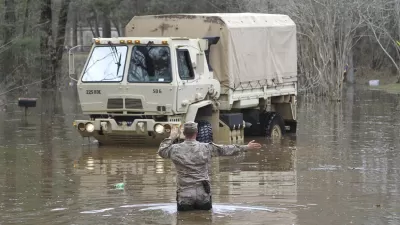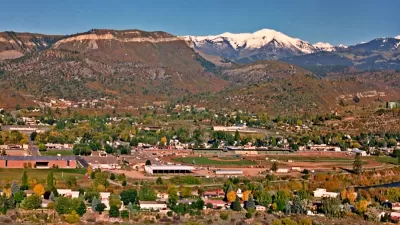The U.S. Department of Agriculture in January announced an ambitious, and only partially funded, new plan to reduce wildfire risks for communities around the United States.

The Biden administration recently announced a new federal program, with funding from the Infrastructure Investment and Jobs Act (IIJA), to thin forests and reduce wildfire risk on 50 million acres in the United States.
A "Wildfire Risk Strategy" [pdf] announced in January by the U.S. Department of Agriculture would spend an estimated $20 billion over 10 years for work in national forests, in addition to $30 billion for work on other federal, state, tribal, and private lands.
Agriculture Secretary Tom Vilsak announced the plan, with the longer title "Confronting the Wildfire Crisis: A Strategy for Protecting Communities and Improving Resilience in America’s Forests," with a press release on January 18.
"The strategy outlines the need to significantly increase fuels and forest health treatments to address the escalating crisis of wildfire danger that threatens millions of acres and numerous communities across the United States," according to the press release.
In addition to the new levels of funding, the plan also proposes a change to wildfire prevention strategy by focusing risk mitigation at the wildland-urban interface—specifically what Forest Service scientists have identified as high risk "firesheds, described by the press release as "large, forested landscapes with a high likelihood that an ignition could expose homes, communities, infrastructure and natural resources to wildfire."
As noted in an article by Alyssa Lupkat for the New York Times, the Agriculture Department is proposing to spend $655 million annually on forests for the first five years of the new Wildfire Risk Strategy. "That money would be added to $262 million that the U.S. Forest Service had already allocated to the task for this year," according to Lupkat. With an initial $3 billion from the IIJA, the full $50 billion of spending proposed by the ten-year plan has not yet been allocated.
FULL STORY: Secretary Vilsack Announces New 10 Year Strategy to Confront the Wildfire Crisis

Alabama: Trump Terminates Settlements for Black Communities Harmed By Raw Sewage
Trump deemed the landmark civil rights agreement “illegal DEI and environmental justice policy.”

Study: Maui’s Plan to Convert Vacation Rentals to Long-Term Housing Could Cause Nearly $1 Billion Economic Loss
The plan would reduce visitor accommodation by 25% resulting in 1,900 jobs lost.

Why Should We Subsidize Public Transportation?
Many public transit agencies face financial stress due to rising costs, declining fare revenue, and declining subsidies. Transit advocates must provide a strong business case for increasing public transit funding.

Paris Bike Boom Leads to Steep Drop in Air Pollution
The French city’s air quality has improved dramatically in the past 20 years, coinciding with a growth in cycling.

Why Housing Costs More to Build in California Than in Texas
Hard costs like labor and materials combined with ‘soft’ costs such as permitting make building in the San Francisco Bay Area almost three times as costly as in Texas cities.

San Diego County Sees a Rise in Urban Coyotes
San Diego County experiences a rise in urban coyotes, as sightings become prevalent throughout its urban neighbourhoods and surrounding areas.
Urban Design for Planners 1: Software Tools
This six-course series explores essential urban design concepts using open source software and equips planners with the tools they need to participate fully in the urban design process.
Planning for Universal Design
Learn the tools for implementing Universal Design in planning regulations.
Smith Gee Studio
Alamo Area Metropolitan Planning Organization
City of Santa Clarita
Institute for Housing and Urban Development Studies (IHS)
City of Grandview
Harvard GSD Executive Education
Toledo-Lucas County Plan Commissions
Salt Lake City
NYU Wagner Graduate School of Public Service





























